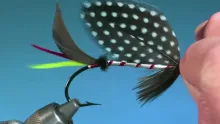Advice on how to lay out a good classical salmon fly.
Although each salmon fly pattern may call for its' own proportions and components, the following diagram and table identifies the standard anatomy and proportions used in salmon fly tying. Understanding proper proportions is essential to world-class salmon fly tying. (see also The Salmon Fly Proportion, Design & Layout Guide)

| SALMON FLY PROPORTION CHART | |
| Tag | With the hook shank parallel to the tying surface, the tag starts at the barb point and proceeds to the hook point. The tag may consist of several materials such as tinsel and floss. |
| Tail | Length is 1-1/2 of the hook gape, Height is 1/2 to equal of the hook gape |
| Tail Veiling | Length is 1/2 of the tail |
| Butt | Typically 3-5 wraps of material: osterich, dubbing, etc. |
| Body | From the butt to 1 hook-eye length back from the head |
| Ribbing | Generally, palmered tinsel or floss; 5 wraps from butt to head |
| Body Hackle | A feather folded over and palmered behind the body ribbing |
| Main Wing | Length is from the head to where the topping & roof meet the tail, not to exceed out of the borders of the two |
| Roof | Length is from the head to the tailing, height is approx. equal to 1/2 to 3/4 hook gape |
| Topping | Length is from the head to the tip of the tailing, height is approx. equal to one hook gape. |
| Shoulder(s) | Length is approx 2/3 of main wing, or to the butt |
| Cheek(s) | Length is generally 1/2 of shoulder |
| Horns | Length equal to intersection of topping and tailing |
| Throat | Length is just a smidgen longer than the body palmered hackle extending to 1/2 the distance from the hook eye and hook point |
| Throat Veiling | Length is max to the length of the throat, sparsely tied |
| Head | Evenly tapered and not grossly large. The smaller the better. Finish with gloss coat on thread-based heads. |
- Log in to post comments








What spey fly uses Merganzer
Hello,
Could you tell me what spey fly uses Merganzer and Cermerrains feathers.
Thanks nice sight.
Meaning...?
Hava,
Something better to do... meaning...?
Something aside from doing The Global FlyFisher or articles on salmon fly anatomy?
How about fishing? ;-)
We do that a lot!
Martin
Very nice
Very, nice, i got much needed infomation, but really, you guys need somthing better to do. Dont you think?
Thank you, really really helpful.
Thank you, really really helpful.
Correct proportion information and where to tie in specific parts of the fly is so relevant. I have also searched many times for what I may call 'hints & tips' or 'tricks of the trade', as there are several techniques used in salmon fly tying that are not obvious to the new comer to fly tying.
For example, I have often doubled a hackle and pulled the barbs back as the hackle is wound. But it was not until I watched Ally Gowan's video on tying his Ally's Shrimp that I saw how easy it was to double a hackle by running the blade of a pair of scissors down the hackle shaft! To me sheer genius.
There's a book to be written (or video to be made) that could be a 'good little earner' by someone who has the gift, in compiling Salmon Flytying - Hints & Tips and Tricks of the Trade.